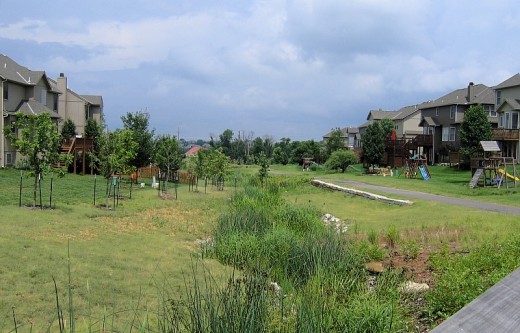Read the start of this article below; to view full article you need to be a PlannersWeb member. Already a member? — be sure you’re logged-in. Not a member? Consider joining the PlannersWeb.
 In the first two installments of this series, we presented basic information about what LID is and how it works. In this piece, we’ll show that LID isn’t simply a stormwater management technique, but a systems approach that provides multiple benefits addressing both public and private sector interests. To help you decide if LID may be right for your community, and with our apologies to David Letterman, we present:
In the first two installments of this series, we presented basic information about what LID is and how it works. In this piece, we’ll show that LID isn’t simply a stormwater management technique, but a systems approach that provides multiple benefits addressing both public and private sector interests. To help you decide if LID may be right for your community, and with our apologies to David Letterman, we present:
The Top Ten Benefits of Low Impact Development:
10. Low Impact Development blends into the landscape.
By integrating LID Integrated Management Practices (IMPs) into site design accounting for both specific site conditions and overall conditions in the watershed, one can achieve an overall site design that is functional, appropriate, and aesthetic. Some of the most commonly used IMPs include: permeable pavement; rainwater harvesting (rain barrels and cisterns); bioretention (greenways, riparian corridors, vegetated swales, percolation trenches, and rain gardens); green roofs; and level spreaders which can be incorporated into site design, parking lots, and native-species landscaping.
LID also makes the maximum use of existing natural systems. Wetlands can be used for natural water filtration, and streams can be reconnected to floodplains for storage of floodwaters. Using natural systems allows the least cost alternative, providing a class of benefits known as “ecosystem services,” for which benefits can be monetized as either avoided costs or direct benefits.
9. LID mimics the natural system.
Communities can use LID to overcome stormwater impacts caused by urbanization. Lot-level application of IMPs can provide similar functions of the natural hydrologic system composed of stream, riparian corridor, wetlands, and floodplains by retaining stormwater on site and allowing it to recharge groundwater — slowly releasing it to surface water, or capturing it onsite for future use in irrigation. In this way LID creates a built environment that functions much more closely to the way the natural environment works. The result is a landscape that generates less surface runoff, less water pollution, less erosion, and less overall damage to streams, rivers, and lakes.
8. LID provides aesthetic benefits.
In particular, stream buffers, bioretention facilities, greenways, and green parking lots can provide attractive and aesthetically-pleasing greenspace that is publicly accessible or simply part of the streetscape. This aesthetic character in turn contributes to livability, value, sense of place, and overall quality of life.

7. LID reduces flood risk.
IMPs function effectively to capture the first 1.5 to 2 inches of rainfall runoff, which is 75 to 95 percent of the rainfall events in most location in the United States. Urbanized and urbanizing watersheds can experience localized flooding during these rainfall events due to the amount of impervious surface that accompanies development. LID captures this runoff and retains it on site, rather than allowing it to flow downstream into streets or nearby properties.
6. LID provides multiple ecological benefits.
IMPs reduce the amount of impervious surface; increase the amount of groundwater recharge; cool stormwater runoff before it enters and impacts streams; reduce the amount of nonpoint source pollution reaching streams; decrease the heat island effect in urbanized areas; provide improved wildlife habitat; and even reduces smog. For an excellent overview of these ecological benefits, see the EPA’s Low Impact Development (LID) “Barrier Busters” Fact Sheet Series.
End of excerpt
Article continues with:
5. LID increases quality of life.
4. LID promotes economic competitiveness.
3. LID improves community resilience to climate change.
2. LID is cost effective.
1. LID increases property values.
Jim Segedy, FAICP, worked for many years in Ball State University’s Community Based Planning program, providing assistance to more than one hundred communities and many plan commissions (as planning commissions are called in Indiana). He is currently an adjunct Professor of Urban Studies at the University of Pittsburgh; and a member of the Edgewood, Pennsylvania, Planning Commission.
Lisa Hollingsworth-Segedy, AICP, is the Associate Director for River Restoration for American Rivers’ Pittsburgh field office. Before moving to Pennsylvania, she spent over a decade as a circuit-riding planner for a regional planning organization serving the western fringe of Metropolitan Atlanta.
You must be logged in or a PlannersWeb member to read the rest of the article.